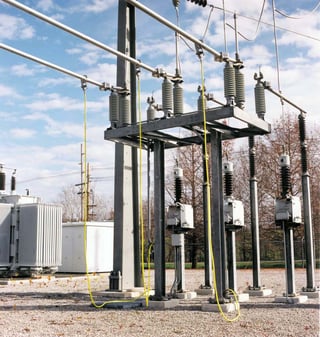“We have been searching for better ways to implement our policy for substation grounding almost since we adopted it. While the grounding equipment we’ve been using is the widely-accepted standard for this application, it has always had room for improvement in practice,” shared a utility.
Many utilities today are searching for improved solutions for their grounding practices. Long gone are the days of fuzzing the line and simply throwing a chain over the conductor or bus to ground it. With increased understanding and technology, temporary protective grounding equipment and practices have evolved to keep linemen safer while working on de-energized lines and substations.
for their grounding practices. Long gone are the days of fuzzing the line and simply throwing a chain over the conductor or bus to ground it. With increased understanding and technology, temporary protective grounding equipment and practices have evolved to keep linemen safer while working on de-energized lines and substations.
Download the Encyclopedia of Grounding.
At the same time, load demands have increased and requirements for higher rated equipment that will handle high asymmetrical fault currents are becoming commonplace for many utilities. CHANCE® grounding equipment provides a variety of solutions for your substation grounding needs.
Large bus bar clamps with 4/0 copper grounding cable, which may be installed with assistance from a shepherd hook lift stick, are still used for ASTM F855 Grade 5 applications. The shepherd hook lift stick is placed in turn over each phase and the attached rope block assembly is used to pull up the heavy bus bar ground sets.
Ball studs and ball stud/socket clamps offer a lighter alternative. The ball studs are permanently installed on the grounded substation structure and on the buses or NEMA pads. Ball stud clamps are less than half the weight of large bus bar clamps and can be installed using a standard grip-all clamp stick. These are typically used for ASTM F855 Grade 5 and 5H applications. Longer ball studs also offer the flexibility to install a c-clamp or duckbill clamp on the shaft as an alternative to a ball stud clamp.
Some utilities are opting to permanently install grounding studs with a flat or hex end instead of ball studs. When installed on larger buses, these grounding studs allow the utility to use the same ground sets with c-clamps or duckbill clamps that are being used for smaller buses or overhead lines. The ground sets, of course, need to meet the required ratings and have the proper length cable. These grounding studs are used for applications up to ASTM F855 grades 5H and 7H.
Large bus bar clamps with integral rated studs are relatively new to the industry. They do not have a cable/ferrule attached and are installed onto the large buses using a grip-all clamp stick. A properly sized and rated ground set with a smaller and lighter clamp can then be installed on the rated stud, also using a grip-all clamp stick. These are typically used for ASTM F855 Grade 5H and 7H applications.
For smaller buses and ground end connections, there are many options including c-clamps, duckbill clamps, flat-face clamps, and all-angle clamps. All-angle clamps provide flexibility to install from nearly any angle for hard to reach buses.
Regardless of the equipment you choose, always make sure it is rated to handle your maximum available fault current with its duration and asymmetry factor, and be sure to use equipotential grounding. Contact our team for more information or training opportunities. 

